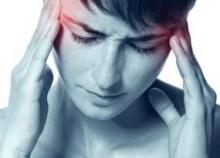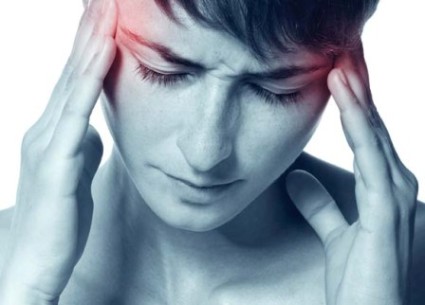User login
LOS ANGELES – Contrasting with current classification criteria and the usual wisdom that attacks of migraine with aura have discrete phases, new data suggest that headache is more often than not already present during the aura phase.
In a prospective, diary-based study of 201 adults experiencing 861 attacks of migraine with aura, headache was reported within 15 minutes of the onset of aura in 61% of attacks, researchers reported at the annual meeting of the American Headache Society.
Additionally, more than half of the attacks met formal diagnostic criteria for migraine or pragmatic criteria for probable migraine within this time frame.
"These results do not seem to be consistent with the current ICHD-2 [International Classification of Headache Disorders, second edition] classification that states that migraine headache usually follows the aura symptoms; that’s not the case here," commented lead researcher Dr. Jakob M. Hansen of the headache research and treatment program at the University of California, Los Angeles and the Danish Headache Center at the University of Copenhagen.
"Furthermore, we have already headache at the onset of aura, and that does seem to conflict with the idea that you have to have a [cortical] spreading depression to activate the trigeminovascular system to cause headache."
"These data suggest that the phases of migraine attack may not be as discrete as originally believed. This is food for thought," he added.
Session attendee Dr. Jes Olesen, also of the University of Copenhagen, was skeptical of the findings, however, noting that they contrast with those of large studies in which careful histories were taken. "Always when you find something that is clearly in contrast to what is sort of conventional wisdom, we have to think about possible sources of error. ... My idea is it could be because people are mixing up a little bit attacks with and without aura ... because patients tend to mix these things up if you don’t instruct them very, very carefully," he said.
"The good thing is, for [patients] to report anything during the study, they should have an aura that they were familiar with to include an attack. I think it’s highly unlikely that people were having a migraine attack without aura. They were asked in the electronic diary, ‘Do you have an aura right now?’ " Dr. Hansen explained. "Of course it’s possible that they answered, ‘Yes, I do,’ because we reminded them. But I think it’s unlikely that so many patients would respond wrongly to a very simple question like that."
Dr. Werner Becker of the University of Calgary (Alta.), who also attended the session, commented that "migraine patients who have premonitory symptoms will often report nausea or photophobia or phonophobia even during their premonitory phase, so I’m not all that surprised that maybe symptoms are occurring during the aura as well.
"Having said that, your findings of so much headache during the aura are very interesting. But I suppose your results are consistent with the idea that the hypothalamus activation is perhaps the first part of the migraine attack," he added.
Dr. Hansen and his coinvestigators studied patients who were enrolled in a randomized therapeutic trial and had migraine with aura.
In the first phase of the study (456 attacks), patients reported the time elapsed since aura onset in quarter hours, as well as pain intensity and associated symptoms. In the second phase (405 attacks), they reported baseline pain and associated symptoms within 1 hour of aura onset, immediately before treatment.
Results showed that for 61% of attacks in the study’s first phase, headache was already present at 0-15 minutes after aura onset, Dr. Hansen reported. Patients also commonly had nausea (40%), photophobia (84%), and phonophobia (67%) at this very early phase.
Additionally, a large proportion of attacks met criteria for migraine with aura within 15 minutes of the onset of aura: 22% with use of the stricter ICHD-2 criteria for migraine with aura, and 54% with use of less strict, pragmatic criteria for probable migraine with aura (defined as migraine aura plus any-intensity headache plus at least one associated symptom among nausea/vomiting, photophobia, and phonophobia).
"These results were, of course, somewhat surprising to us because of the conflict with many of the firmly held beliefs" on migraine with aura, Dr. Hansen commented. Nonetheless, "it seems that headache and migraine symptoms are present during the aura phase."
(For all attacks studied, headache occurred within an hour of aura onset in 73%; some 31% met the ICHD-2 criteria for migraine with aura, whereas 65% met the pragmatic criteria for probable migraine with aura.)
Dr. Hansen disclosed no relevant financial conflicts of interest.
LOS ANGELES – Contrasting with current classification criteria and the usual wisdom that attacks of migraine with aura have discrete phases, new data suggest that headache is more often than not already present during the aura phase.
In a prospective, diary-based study of 201 adults experiencing 861 attacks of migraine with aura, headache was reported within 15 minutes of the onset of aura in 61% of attacks, researchers reported at the annual meeting of the American Headache Society.
Additionally, more than half of the attacks met formal diagnostic criteria for migraine or pragmatic criteria for probable migraine within this time frame.
"These results do not seem to be consistent with the current ICHD-2 [International Classification of Headache Disorders, second edition] classification that states that migraine headache usually follows the aura symptoms; that’s not the case here," commented lead researcher Dr. Jakob M. Hansen of the headache research and treatment program at the University of California, Los Angeles and the Danish Headache Center at the University of Copenhagen.
"Furthermore, we have already headache at the onset of aura, and that does seem to conflict with the idea that you have to have a [cortical] spreading depression to activate the trigeminovascular system to cause headache."
"These data suggest that the phases of migraine attack may not be as discrete as originally believed. This is food for thought," he added.
Session attendee Dr. Jes Olesen, also of the University of Copenhagen, was skeptical of the findings, however, noting that they contrast with those of large studies in which careful histories were taken. "Always when you find something that is clearly in contrast to what is sort of conventional wisdom, we have to think about possible sources of error. ... My idea is it could be because people are mixing up a little bit attacks with and without aura ... because patients tend to mix these things up if you don’t instruct them very, very carefully," he said.
"The good thing is, for [patients] to report anything during the study, they should have an aura that they were familiar with to include an attack. I think it’s highly unlikely that people were having a migraine attack without aura. They were asked in the electronic diary, ‘Do you have an aura right now?’ " Dr. Hansen explained. "Of course it’s possible that they answered, ‘Yes, I do,’ because we reminded them. But I think it’s unlikely that so many patients would respond wrongly to a very simple question like that."
Dr. Werner Becker of the University of Calgary (Alta.), who also attended the session, commented that "migraine patients who have premonitory symptoms will often report nausea or photophobia or phonophobia even during their premonitory phase, so I’m not all that surprised that maybe symptoms are occurring during the aura as well.
"Having said that, your findings of so much headache during the aura are very interesting. But I suppose your results are consistent with the idea that the hypothalamus activation is perhaps the first part of the migraine attack," he added.
Dr. Hansen and his coinvestigators studied patients who were enrolled in a randomized therapeutic trial and had migraine with aura.
In the first phase of the study (456 attacks), patients reported the time elapsed since aura onset in quarter hours, as well as pain intensity and associated symptoms. In the second phase (405 attacks), they reported baseline pain and associated symptoms within 1 hour of aura onset, immediately before treatment.
Results showed that for 61% of attacks in the study’s first phase, headache was already present at 0-15 minutes after aura onset, Dr. Hansen reported. Patients also commonly had nausea (40%), photophobia (84%), and phonophobia (67%) at this very early phase.
Additionally, a large proportion of attacks met criteria for migraine with aura within 15 minutes of the onset of aura: 22% with use of the stricter ICHD-2 criteria for migraine with aura, and 54% with use of less strict, pragmatic criteria for probable migraine with aura (defined as migraine aura plus any-intensity headache plus at least one associated symptom among nausea/vomiting, photophobia, and phonophobia).
"These results were, of course, somewhat surprising to us because of the conflict with many of the firmly held beliefs" on migraine with aura, Dr. Hansen commented. Nonetheless, "it seems that headache and migraine symptoms are present during the aura phase."
(For all attacks studied, headache occurred within an hour of aura onset in 73%; some 31% met the ICHD-2 criteria for migraine with aura, whereas 65% met the pragmatic criteria for probable migraine with aura.)
Dr. Hansen disclosed no relevant financial conflicts of interest.
LOS ANGELES – Contrasting with current classification criteria and the usual wisdom that attacks of migraine with aura have discrete phases, new data suggest that headache is more often than not already present during the aura phase.
In a prospective, diary-based study of 201 adults experiencing 861 attacks of migraine with aura, headache was reported within 15 minutes of the onset of aura in 61% of attacks, researchers reported at the annual meeting of the American Headache Society.
Additionally, more than half of the attacks met formal diagnostic criteria for migraine or pragmatic criteria for probable migraine within this time frame.
"These results do not seem to be consistent with the current ICHD-2 [International Classification of Headache Disorders, second edition] classification that states that migraine headache usually follows the aura symptoms; that’s not the case here," commented lead researcher Dr. Jakob M. Hansen of the headache research and treatment program at the University of California, Los Angeles and the Danish Headache Center at the University of Copenhagen.
"Furthermore, we have already headache at the onset of aura, and that does seem to conflict with the idea that you have to have a [cortical] spreading depression to activate the trigeminovascular system to cause headache."
"These data suggest that the phases of migraine attack may not be as discrete as originally believed. This is food for thought," he added.
Session attendee Dr. Jes Olesen, also of the University of Copenhagen, was skeptical of the findings, however, noting that they contrast with those of large studies in which careful histories were taken. "Always when you find something that is clearly in contrast to what is sort of conventional wisdom, we have to think about possible sources of error. ... My idea is it could be because people are mixing up a little bit attacks with and without aura ... because patients tend to mix these things up if you don’t instruct them very, very carefully," he said.
"The good thing is, for [patients] to report anything during the study, they should have an aura that they were familiar with to include an attack. I think it’s highly unlikely that people were having a migraine attack without aura. They were asked in the electronic diary, ‘Do you have an aura right now?’ " Dr. Hansen explained. "Of course it’s possible that they answered, ‘Yes, I do,’ because we reminded them. But I think it’s unlikely that so many patients would respond wrongly to a very simple question like that."
Dr. Werner Becker of the University of Calgary (Alta.), who also attended the session, commented that "migraine patients who have premonitory symptoms will often report nausea or photophobia or phonophobia even during their premonitory phase, so I’m not all that surprised that maybe symptoms are occurring during the aura as well.
"Having said that, your findings of so much headache during the aura are very interesting. But I suppose your results are consistent with the idea that the hypothalamus activation is perhaps the first part of the migraine attack," he added.
Dr. Hansen and his coinvestigators studied patients who were enrolled in a randomized therapeutic trial and had migraine with aura.
In the first phase of the study (456 attacks), patients reported the time elapsed since aura onset in quarter hours, as well as pain intensity and associated symptoms. In the second phase (405 attacks), they reported baseline pain and associated symptoms within 1 hour of aura onset, immediately before treatment.
Results showed that for 61% of attacks in the study’s first phase, headache was already present at 0-15 minutes after aura onset, Dr. Hansen reported. Patients also commonly had nausea (40%), photophobia (84%), and phonophobia (67%) at this very early phase.
Additionally, a large proportion of attacks met criteria for migraine with aura within 15 minutes of the onset of aura: 22% with use of the stricter ICHD-2 criteria for migraine with aura, and 54% with use of less strict, pragmatic criteria for probable migraine with aura (defined as migraine aura plus any-intensity headache plus at least one associated symptom among nausea/vomiting, photophobia, and phonophobia).
"These results were, of course, somewhat surprising to us because of the conflict with many of the firmly held beliefs" on migraine with aura, Dr. Hansen commented. Nonetheless, "it seems that headache and migraine symptoms are present during the aura phase."
(For all attacks studied, headache occurred within an hour of aura onset in 73%; some 31% met the ICHD-2 criteria for migraine with aura, whereas 65% met the pragmatic criteria for probable migraine with aura.)
Dr. Hansen disclosed no relevant financial conflicts of interest.
AT THE ANNUAL MEETING OF THE AMERICAN HEADACHE SOCIETY
Major Finding: In 61% of attacks, headache was already present within 15 minutes of the onset of aura.
Data Source: This was a prospective, diary-based study of 201 adult patients experiencing 861 attacks of migraine with aura.
Disclosures: Dr. Hansen disclosed no relevant financial conflicts of interest.


